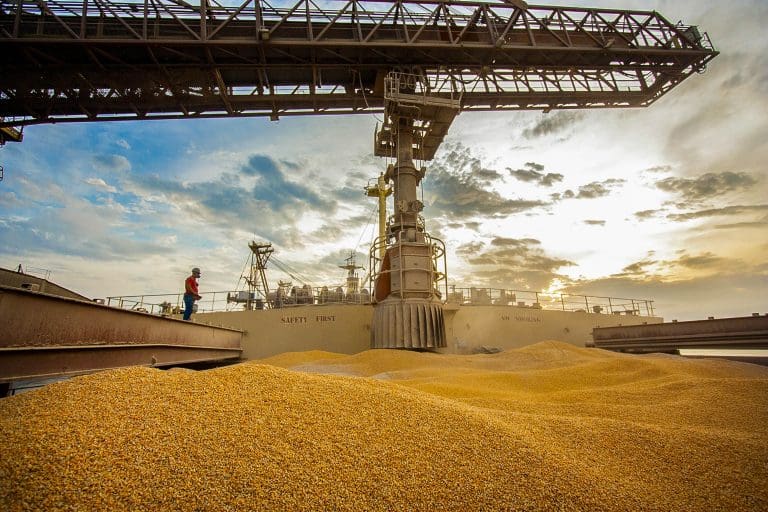
Brazil is the world’s second-largest corn exporter and looks set to ramp up its exports to China. Photo: Abramilho
HARVEST of this season’s safrinha corn crop in Brazil has commenced, with the earliest-planted fields in the Central Western state Mato Grosso first cab off the rank. According to the Mato Grosso Institute of Agricultural Economy (IMEA), 1.24 per cent of the state’s crop had been harvested as of May 20.
The start of this year’s harvest coincided with the news last week that China, in pursuit of improved food security in the wake of the Ukraine crisis, has signed an accord with the Brazilian Government to increase cooperation in the agricultural trade sphere, in particular corn.
According to a statement from China’s Ministry of Commerce, China’s General Administration of Customs (GAC) and Brazil’s Ministry of Agriculture had agreed on an updated protocol outlining the phytosanitary requirements for the export of Brazilian corn into China. The two countries had previously signed a phytosanitary protocol back in 2014, but China has rarely imported corn from Brazil in the ensuing years. In the 2021-22 marketing year to date, China has imported one 35,000-tonne cargo, the only trade of note since 2019. The major impediments to trade were said to be the long shipping time and high freight cost relative to the United States and Ukraine, with issues around genetically modified grain also adding to the challenge.
Brazilian corn growers’ association Abramilho said last week that any large-scale corn exports to China will require an agreement around genetically modified grains before shipments can commence, as more than 90pc of Brazil’s corn production is transgenic. That said, the Chinese are reportedly keen to sign such an agreement, thereby removing the last impediment to physical trade. It would then take around three months for the Brazilian Government to have the agreed export protocols in place to facilitate the loading of export vessels.
China buying climbs
China’s imports of corn have grown substantially in recent years, peaking at around 29.5 million tonnes (Mt) in the 2020-21 marketing year. That is expected to drop back to around 23Mt in the current marketing year, with almost all of those imports currently coming from the US and Ukraine. Ukraine first shipped corn to China in April 2012, being much cheaper than the US at the time and not genetically modified. Roll the clock forward to 2021, and Ukraine accounted for almost one-third of total Chinese corn imports, with virtually the entire balance supplied by the US.
However, Russia’s invasion of Ukraine has severely disrupted corn shipments out of Ukraine’s Black Sea ports in 2022, prompting a significant tilt in global trade flows. Consumers worldwide, including China, are scrambling to secure ongoing supplies from alternate, more politically stable origins. And there is undoubtedly plenty of scepticism around Russia’s reported agreement to open humanitarian shipping lanes from Ukraine’s Black Sea ports.
As the war in Ukraine rolls on, Beijing’s latest deal with Brazil will primarily be aimed at replacing all, or at least a significant proportion, of Black Sea-origin corn imports. But in the longer term, it could potentially reshape China’s corn-import regime, potentially taking export share away from the US and encouraging the expansion of corn plantings in Brazil. Around one-quarter of US corn exports currently make their way to China.
Behind the US, Brazil is the second-largest exporter of corn in the world. Most of its shipments go to Iran, Spain, Japan, Vietnam and Egypt. But with last week’s announcement came rumours that China had already purchased 250,000-400,000t of Brazilian corn for September shipment, pending ratification of the required agreements in both jurisdictions.
The week ended with more rumours, this time 500,000t of Chinese corn purchases, with analysts suggesting Brazil as the likely origin as it was around US$20/t cheaper than the US. However, export corn premiums out of Brazil have spiked on news of the updated export protocols to China, and new-crop corn basis out of the Gulf of Mexico could well be cheaper for shipment slots in September and beyond.
But the Chinese work in strange ways, as we know all too well here in Australia. On the very same day that the corn deal surfaced, China temporarily suspended beef imports from four Brazilian slaughterhouses. Announced by GAC, the suspension came with no notice, was effective immediately and did not detail the reason for the ban. One of the plants is believed to have been banned for a month and the other three for one week.
Safrinha crop in trouble
Meanwhile, it has been a tough season for this year’s safrinha corn crop, which traditionally accounts for around 70pc of the country’s total corn production and about 75pc of total corn exports. While the crop was planted into good moisture, output in the states of Mato Grosso, Goiás and Minas Gerais, which account for around 60pc of Brazil’s second corn-crop output, have been under the threat of drought since emergence. And now, frost is a threat to production in the southern states of Mato Grosso do Sul and Parana, which account for roughly 30pc of the safrinha corn production in Brazil. The south has escaped the drought woes, with rainfall registrations adequate in most areas to abundant in some since the crop was planted in February.
However, early morning temperatures have been flirting with zero in many districts, threatening to scuttle this season’s production hopes. Refinitiv has reportedly cut its corn production estimate to 111.5Mt as the continued dryness in the north, and unfavourable frost events in the south, adversely impact crop yields. This is 3.1Mt below Conab’s latest projection of 114.6Mt and 4.5Mt below the USDA’s May forecast of 116Mt.
Global food security and domestic food inflation continue to influence government policy and grain-trade decisions around the world. Even before COVID-19 reduced incomes and disrupted international supply chains, hunger was on the rise. The ongoing conflict in Ukraine and the persistence of La Niña only add to the wave of food insecurity.

HAVE YOUR SAY